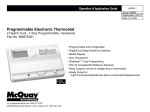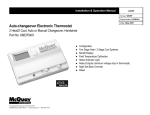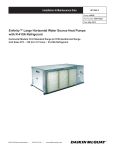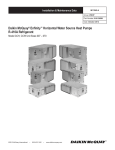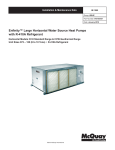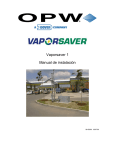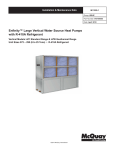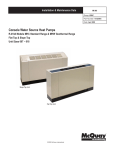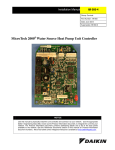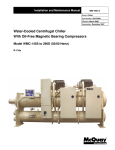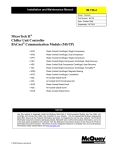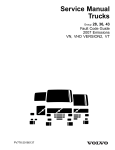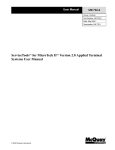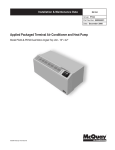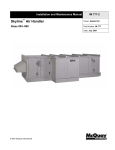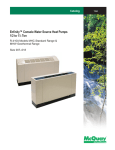Download MTD 070 Series Unit installation
Transcript
Installation & Maintenance Data IM 526-17 Group: WSHP Part Number: 106581303 Date: June 2006 Large Horizontal Water Source Heat Pump Units Size 070, 090, 120 Model CDD, CDE, CDL, CDS, CME, CMG, CMS ® ©2006 McQuay International Contents Unit Operation . . . . . . . . . . . . . . . . . . . . . . . . . . . . . 13-15 Sequence of Operation . . . . . . . . . . . . . . . . . . . . . . . . . 14 Thermostat Connections . . . . . . . . . . . . . . . . . . . . . 16-17 Motorized Valve & Relay . . . . . . . . . . . . . . . . . . . . . . . . 18 Pump Restart Relay. . . . . . . . . . . . . . . . . . . . . . . . . . . . 19 Boilerless System Kit. . . . . . . . . . . . . . . . . . . . . . . . . . . 20 Field Installed Options on MicroTech Units . . . . . . . . . . 21 Troubleshooting WSHP . . . . . . . . . . . . . . . . . . . . . . . . . 22 Maintenance . . . . . . . . . . . . . . . . . . . . . . . . . . . . . . . . . 23 Model Nomenclature . . . . . . . . . . . . . . . . . . . . . . . . . . . . 2 Transportation & Storage . . . . . . . . . . . . . . . . . . . . . . . . . 3 Installation . . . . . . . . . . . . . . . . . . . . . . . . . . . . . . . . . . 3-6 Electrical Data . . . . . . . . . . . . . . . . . . . . . . . . . . . . . . . . . 7 Piping . . . . . . . . . . . . . . . . . . . . . . . . . . . . . . . . . . . . . . . 7 Cleaning & Flushing System . . . . . . . . . . . . . . . . . . . . . 8-9 Start-up. . . . . . . . . . . . . . . . . . . . . . . . . . . . . . . . . . . . . . 9 Operating Limits . . . . . . . . . . . . . . . . . . . . . . . . . . . . . . 10 Typical Wiring Diagrams . . . . . . . . . . . . . . . . . . . . . . 11-12 Model Nomenclature W CDD 1 009 D Z Product Catagory W = WSHP Coil Options None Product Identifier See box below Voltage F = 208/23-60-3 K = 460-60-3 L = 575-60-3 N = 380-50-3 Design Series 1 = A Design 2 = B Design 3 = C Design 4 = D Design 5 = E Design Nominal Capacity 070 = 70,000 090 = 90,000 120 = 120,000 McQuay Product Identifiers CDD = Ceiling Mtd./DDC Control/Ext. Range/Less Board CDE = Ceiling Mtd./DDC Control/Ext. Range CDL = Ceiling Mtd./DDC Control/Std. Range/Less Board CDS = Ceiling Mtd./DDC Control/Std. Range CME = Ceiling Mtd./Mark IV/Ext. Range CMG = Ceiling Mtd./Mark IV/Geothermal CMS = Ceiling Mtd./Mark IV/Std. Range Note: Installation and maintenance are to be performed only by qualified personnel who are familiar with local codes and regulations, and are experienced with this type of equipment. Caution: Sharp edges are a potential injury hazard. Avoid contact with them. Page 2 / IM 526 Transportation & Storage Upon receipt of the equipment, check carton for visible damage. Make a notation on the shipper’s delivery ticket before signing. If there is any evidence of rough handling, immediately open the cartons to check for concealed damage. If any damage is found, notify the carrier within 48 hours to establish your claim and request their inspection and a report. The Warranty Claims Department should then be contacted. Do not stand or transport the machines on end. For storing, each carton is marked with “up” arrows. In the event that elevator transfer makes up-ended positioning unavoidable, absolutely ensure that the machine is in the normal upright position for at least 24 hours before operating. Temporary storage at the job site must be indoors, completely sheltered from rain, snow, etc. High or low temperatures naturally associated with weather patterns will not harm the conditioners. Excessively high temperatures, 140°F (60°C) and higher, may deteriorate certain plastic materials and cause permanent damage. Installation General 1. To prevent damage, this equipment should not be operated for supplementary heating and cooling during the construction period. 7. The installing contractor will find it beneficial to confer with piping, sheet metal, ceiling and electrical foremen before installing any conditioners. 2. Inspect the carton for any specific tagging numbers indicated by the factory per a request from the installing contractor. At this time the voltage, phase and capacity should be checked against the plans. NOTE: Check the unit name plate for correct voltage with the plans before installing the equipment. Also, make sure all electrical ground connections are made in accordance with local code. 3. Check the unit size against the plans to ensure unit installation is in the correct location. 4. After removing the carton, remove the hanger kit from the fan housing. 5. Before installation, check the available ceiling height versus the height of the unit. 8. Remove all shipping blocks in the fan wheel. 9. We recommend that the contractor cover the conditioners with plastic film to protect the machines during finishing of the building. This is critical while spraying fireproofing material on bar joists, sandblasting, spray painting and plastering. 6. Note the location and routing of water piping, condensate drain piping, and electrical wiring. The locations of these items are clearly marked on submittal drawings. IM 526 / Page 3 Unit Location 1. Locate the unit in an area that allows for easy removal of the filter and access panels. Leave enough space for service personnel to perform maintenance or repair. Provide sufficient room to make water, electrical and duct connections. 2. The contractor should make sure that adequate ceiling panel access exists, including clearance for hanger brackets, duct collars and fittings at water and electrical connections. 3. Allow adequate room below the unit for a condensate trap and do not locate the unit above pipes. 5. Each unit is furnished with a hanger kit. The kit is shipped unassembled and includes hanger brackets, rubber isolators, washers, bolts and lock washers. Lay out the threaded rods per the dimensions in Figure 1. Assemble the hangers to the unit as shown in Figure 2. Securely tighten the brackets to the unit. 6. When attaching the hanger rods to the unit, a double nut is recommended since vibration could loosen a single nut. The installer is responsible for providing the hex nuts when installing hanger rods. 7. Leave minimum 3" (76 mm) extra threaded rod below the double nuts or minimum 3" (76 mm) clearance between top of unit and ceiling above to facilitate top panel removal for servicing 4. Each unit is suspended from the ceiling by four threaded rods. The rods are attached to the unit corners by a hanger bracket through a rubber isolator. Caution: Do not use rods smaller than specified below. The rods must be securely anchored to the ceiling or to the bar joists. 8. The unit should be pitched towards the drain in both directions to facilitate condensate removal. Figure 1. Hanger bracket detail, sizes 070 thru 120 Figure 2. Unit sizes 070 thru 120 2" (51 mm) 42" (1067 mm) Fan Assembly Comp Comp 44" (1118 mm) Control Box Airflow By McQuay International Coil 80" (2032 mm) 82" (2083 mm) Page 4 / IM 526 2" (51 mm) By Others 5/8” Threaded Rod (By Others) Air Balancing Unit sizes 070 thru 120 are supplied with a variable pitch motor sheave to aid in airflow adjustment. They are set at the factory according to Table 1 shown below. When the final adjustments are complete, the current draw of the motors should be checked and compared to the full load current rating of the motors. The amperage must not exceed the service factor stamped on the motor nameplate. Upon completion of the air balance, it is a common industry recommendation that the variable pitched motor sheave be replaced with a properly sized fixed sheave. A matching fixed sheave will provide longer belt and bearing life and vibration free operation. Initially, it is best to have a variable pitched motor sheave for the purpose of air balancing, but once the balance has been achieved, fixed sheaves maintain balancing and alignment more effectively. Adjustment (See Figure 3) 1. All sheaves should be mounted on the motor or driving shaft with the setscrew “A” toward the motor 2. Be sure both driving and driven sheaves are in alignment and that shafts are parallel. 3. Fit internal key “D” between sheave and shaft, and lock setscrew “A” securely in place. Adjusting 1. Loosen setscrews “B” and “C” in moving parts of sheave and pull out external key “E”. (This key projects a small amount to provide a grip for removing.) Figure 3. 2. Adjust sheave pitch diameter for desired speed by opening moving parts by half or full turns from closed position. Do not open more than five full turns. 3. Replace external key “E” and securely tighten setscrews “B” over key and setscrews “C” into keyway in fixed half of the sheave. 4. Put on belts and adjust belt tension to 4 lbs. – 0.7 lbs. (18N – 3N) for a 1⁄2" to 3⁄4" (13 mm to 19 mm) belt deflection height. 5. To determine the deflection distance from normal position, use a straightedge or stretch a cord from sheave to sheave to use as a reference line. On multiple-belt drives an adjacent undeflected belt can be used as a reference. 6. Future adjustments should be made by loosening the belt tension and increasing or decreasing the pitch diameter of the sheave by half or full turns as required. Readjust belt tension before starting drive. 7. Be sure that all keys are in place and that all setscrews are tight before starting drive. Check setscrews and belt tension after 24 hours service. 8. When new V-belts are installed on a drive, the initial tension will drop rapidly during the first few hours. Check tension frequently during the first 24 hours of operation. Subsequent retensioning should fall between the minimum and maximum force. Figure 4. Drive belt adjustment A Span Le ngth (t) B Deflec tio Force n E D h Key E projects to provide a grip for removing. d D h= C t= Single Groove Table 1. 60 Hz Unit Size 070 090 120 Motor HP 11⁄2 3 11⁄2 3 3 5 C t 64 C2 – ( ) D-d 2 Where: t = Span length, inches (mm) C = Center distance, inches (mm) D = Larger sheave diameter, inches (mm) d = Smaller sheave diameter, inches (m) h = Deflection height, inches (mm) Note: The ratio of deflection to belt span is 1:64. Table 1B. 50 Hz RPM Range 756 – 902 907 –1081 698 – 832 907 –1081 756 – 901 907 –1081 Factory Setting (RPM) 785 904 858 904 814 904 Motor Sheave Position 4 Turns Open 5 Turns Open 11⁄2 Turns Open 5 Turns Open 3 Turns Open 5 Turns Open Unit Size 070 090 120 Motor HP 11⁄2 11⁄2 3 RPM Range 756 – 901 720 – 860 756 – 902 Factory Motor Sheave Setting (RPM) Position 786 4 Turns Open 858 11⁄2 Turns Open 815 3 Turns Open Filter Access Each unit is shipped with a filter bracket for side filter removal. For bottom removal push the filter up into top bracket to gain clearance of bottom bracket and remove the filter. Also, a sheet metal duct filter retainer can be fabricated when return air duct work is used. IM 526 / Page 5 Ductwork & Attenuation Discharge ductwork is normally used with these conditioners. Return air ductwork may also be required. All ductwork should conform to industry standards of good practice as described in the ASHRAE Systems Guide. The discharge duct system will normally consist of a flexible connector at the unit, a transition piece to the full duct size, a short run of duct, an elbow without vanes, and a trunk duct teeing into a branch duct with discharge diffusers as shown in Figure 5. The transition piece must not have angles totaling more than 30° or severe loss of air performance can result. Do not connect the full duct size to the unit without using a transition piece down to the size of the discharge collar on the unit. With metal duct material, the sides only of the elbow and entire branch duct should be internally lined with acoustic fibrous insulation for sound attenuation. Glass fiber duct board material is more absorbing and may permit omission of the canvas connector. The ductwork should be laid out so that there is no line of sight between the conditioner discharge and the distribution diffusers. Return air ducts can be brought in through a low side wall filter-grille and then up through the stud pieces to a ceiling plenum or through air ceiling filter-grilles. The ceiling filter-grille must not be placed directly under the conditioner. Return air ductwork can be connected to the standard filter rack. See Figure 6 (side filter removal shown). The filter rack can be installed for bottom filter removal or side filter removal by locating the brackets. For side filter removal the brackets should be located on the bottom, left side, and top. For bottom filter removal the brackets should be mounted on the left side top and right side with the spring clips supporting the filter. Do not use sheet metal screws directly into the unit cabinet for connection of supply or return air ductwork, especially return air ductwork which can hit the drain pan or the air coil. Figure 5. Figure 6. Filter rack/return air duct collar Both Sides Internally Lined With Acoustic Fibrous Glass Insulation Transformation Piece Square Elbow Trunk Duct Discharge Collar On Heat Pump Canvas Collar Branch Duct Internally Lined With Acoustic Fibrous Insulation Heat Pump Suggested Duct Layout For Multiple Diffuser Application Standard 2" (51 mm) for sizes 070 thru 120 2x2 Ft. Diffuser (Example Only) Ventilation Air Ventilation may require outside air. The temperature of the ventilation air must be controlled so that mixture of outside air and return air entering the conditioner does not exceed conditioner application limits. It is also typical to close off the ventilation air system during unoccupied periods (night setback). The ventilation air system is generally a separate build- Page 6 / IM 526 ing subsystem with distribution ductwork. Simple introduction of the outside air into each return air plenum chamber reasonably close to the conditioner air inlet is not only adequate, but recommended. Do not duct outside air directly to the conditioner inlet. Provide sufficient distance for thorough mixing of outside and return air. See Operating Limits on page 10. Electrical Data General 1. Verify the compatibility between the voltage and phase of the available power and that shown on the unit serial plate. Line and low voltage wiring must comply with local codes or the National Electrical Code, whichever applies. 2. Apply correct line voltage to the unit. A 7⁄8" (22mm) hole and/or a 11⁄8" (29 mm) knockout is supplied on the side of the unit. A disconnect switch near the unit is required by code. Power to the unit must be sized correctly and have dual element (Class RK5) fuses or an HACR circuit breaker for branch circuit overcurrent protection. See the nameplate for correct ratings. 3. Three phase 50 cycle units, 380/50/3, require a neutral wire for 230/50/1 power to the fan circuit. 4. Connect the thermostat/subbase wiring with the power “off ” to the unit. 5. Field supplied relays installed on the input terminals W1, W2, Y1, Y2 or G may introduce electrical noise. Never install relay coils in series with the inputs. 230 Volt Operation All 208-230 volt single-phase and three-phase units are factory wired for 208 volt operation. For 230 phase operation, the line voltage tap on the 24 volt transformer must be changed. Disconnect and cap the red lead wire and interchange it with the orange lead wire on the primary of the 24 volt transformer. Piping 1. All units should be connected to supply and return piping in a two-pipe reverse return configuration. A reverse return system is inherently self-balancing and requires only trim balancing where multiple quantities of units with different flow and pressure drop characteristics exist in the same loop. Check for proper water balance by measuring differential temperature reading across the water connections. To insure proper water flow, the differential flow should be 10°F to 14°F (5°C to 8°C) for units in cooling mode. A direct return system may also work acceptably, but proper water flow balancing is more difficult to achieve and maintain. 2. The piping can be steel, copper or PVC. 3. Supply and return runouts usually join the unit via short lengths of high pressure flexible hose which are sound attenuators for both unit operating noise and hydraulic pumping noise. One end of the hose should have a swivel fitting to facilitate removal for service. Hard piping can also be brought directly to the unit. This option is not recommended since no vibration or noise attenuation can be accomplished. The hard piping must have unions to facilitate unit removal. See Figure 7 for typical piping setup. 4. Some flexible hose threaded fittings are supplied with sealant compound. If not, apply Teflon tape to assure a tight seal. 5. Supply and return shutoff valves are required at each conditioner. The return valve is used for balancing and should have a “memory stop” so that it can always be closed off but can only be reopened to the proper position for the flow required. 6. No unit should be connected to the supply and return piping until the water system has been cleaned and flushed completely. After the cleaning and flushing has taken place, the initial connection should have all valves wide open in preparation for water system flushing. 7. Condensate piping can be steel, copper or PVC. Each unit includes a condensate connection. 8. The condensate disposal piping must have a trap. The piping must be pitched away from the unit not less than 1⁄4" per foot (21 mm per meter) (see Figure 7). Generally, the condensate trap is made of copper and soldered on the unit. A piece of vinyl hose from the trap to the drain line is used for simple removal. A complete copper or PVC condensate system can also be used. IM 526 / Page 7 Union fittings in the copper lines should be applied to facilitate removal. Factory supplied condensate hose assemblies have pipe thread fittings to facilitate connection of a flexible vinyl or steel braided hose. 9. Do not locate any point in the drain system above the drain connection of any unit. Figure 7. Typical Piping 10. Automatic flow controlled devices must not be installed prior to system cleaning and flushing. 11. A high point of the piping system must be vented. 12. Check local code for the need for dielectric fittings. Figure 8. Electrical Access Panel Hanger Kits (4) Flex Hoses 11⁄2" (38 mm) Return Riser 11⁄2" (38 mm) Condensate Riser Ball Valves Optional Cleanout 1⁄4" Per Foot (21 mm Per Meter) Supply Air Supply Riser Note: Do not overtorque fittings. The maximum torque without damage to fittings is 30 foot pounds. If a torque wrench is not available, use as a rule of thumb, finger-tight plus one quarter turn. Use two wrenches to tighten the union, one to hold the line and one for simultaneous tightening of the nut. Cleaning & Flushing System 1. Prior to first operation of any conditioner, the water circulating system must be cleaned and flushed of all construction dirt and debris. If the conditioners are equipped with water shutoff valves, either electric or pressure operated, the supply and return runouts must be connected together at each conditioner location. This will prevent the introduction of dirt into the unit. See Figure 9. Figure 9. Return Runout Supply Runout Mains Flexible Hose Runouts Initially Connected Together 2. Fill the system at the city water makeup connection with all air vents open. After filling, close all air vents. Page 8 / IM 526 The contractor should start main circulator with the pressure reducing valve open. Check vents in sequence to bleed off any trapped air, ensuring circulation through all components of the system. Power to the heat rejector unit should be off, and the supplementary heat control set at 80°F (27°C). While circulating water, the contractor should check and repair any leaks in the piping. Drains at the lowest point(s) in the system should be opened for initial flush and blowdown, making sure city water fill valves are set to make up water at the same rate. Check the pressure gauge at pump suction and manually adjust the makeup to hold the same positive steady pressure both before and after opening the drain valves. Flush should continue for at least two hours, or longer if required, to see clear, clean drain water. 3. Shut off supplemental heater and circulator pump and open all drains and vents to completely drain down the system. Short circuited supply and return runouts should now be connected to the conditioner supply and return connections. Do not use sealers at the swivel flare connections of hoses. 4. Trisodium phosphate was formerly recommended as a cleaning agent during flushing. However, many states and localities ban the introduction of phosphates into their sewage systems. The current recommendation is to simply flush longer with warm 80°F (27°C) water. 5. Refill the system with clean water. Test the water using litmus paper for acidity, and treat as required to leave the water slightly alkaline (pH 7.5 to 8.5). The specified percentage of antifreeze may also be added at this time. Use commercial grade antifreeze designed for HVAC systems only. Do not use automotive grade antifreeze. Once the system has been filled with clean water and antifreeze (if used), precautions should be taken to protect the system from dirty water conditions. Dirty water will result in system wide degradation of performance and solids may clog valves, strainers, flow regulators, etc. Additionally, the heat exchanger may become clogged which reduces compressor service life or caus- es premature failure. A SystemSaver® from McQuay International should be employed to continuously remove solids as the system operates. Contact your local representative for further information on this device. 6. Set the loop water controller heat add setpoint to 70°F (21°C) and the heat rejection setpoint to 85°F (29°C). Supply power to all motors and start the circulating pumps. After full flow has been established through all components including the heat rejector (regardless of season) and air vented and loop temperatures stabilized, each of the conditioners will be ready for check, test and start-up, air balancing, and water balancing. Start-up 1. Open all valves to full open position and turn on power to the conditioner. 2. Set thermostat for “Fan Only” operation by selecting “Off” at the system switch and “On” at the fan switch. If “Auto” fan operation is selected, the fan will cycle with the compressor. Check for proper air delivery. 3. Set thermostat to “Cool.” If the thermostat is an automatic changeover type, simply set the cooling temperature to the coolest position. On manual changeover types additionally select “Cool” at the system switch. Again, many conditioners have time delays which protect the compressor(s) against short cycling. After a few minutes of operation, check the discharge grilles for cool air delivery. Measure the temperature difference between entering and leaving water. It should be approximately 11⁄2 times greater than the heating mode temperature difference. For example, if the cooling temperature difference is 15°F (8°C), the heating temperature difference should have been 10°F (5°C). Without automatic flow control valves, target a cooling temperature difference of 10°F to 14°F (5°C to 8°C). Adjust the combination shutoff/balancing valve in the return line to a water flow rate which will result in the 10˚F to 14°F (5°C to 8°C) difference. 4. Set thermostat to “Heat.” If the thermostat is the automatic changeover type, set system switch to the “Auto” position and depress the heat setting to the warmest selection. Some conditioners have built-in time delays which prevent the compressor from immediately starting. With most control schemes, the fan will start immediately. After a few minutes of compressor operation, check for warm air delivery at discharge grille. If this is a “cold building” start-up, leave unit run- ning until return air to the unit is at least 65°F (18°C). Measure the temperature difference between entering and leaving air and entering and leaving water. With entering water of 60°F to 80°F (16°C to 27°C), leaving water should be 6°F to 12°F (3.3°C to 6.6°C) cooler, and the air temperature rise through the machine should not exceed 35°F (19°C). If the air temperature exceeds 35°F (19°C), then the water flow rate is inadequate. 5. Check the elevation and cleanliness of the condensate line. If the air is too dry for sufficient dehumidification, slowly pour enough water into the condensate pan to ensure proper drainage. 6. If the conditioner does not operate, check the following points: a. Is supply voltage to the machine compatible? b. Is thermostat type appropriate? c. Is thermostat wiring correct? 7. If the conditioner operates but stops after a brief period: a. Is there proper airflow? Check for dirty filter, incorrect fan rotation (3-phase fan motors only), or incorrect ductwork. b. Is there proper water flow rate within temperature limits? Check water balancing; backflush unit if dirtclogged. 8. Check for vibrating refrigerant piping, fan wheels, etc. 9. Do not lubricate the fan motor during the first year of operation as it is prelubricated at the factory. 10. Field supplied relays installed on the input terminals W1, W2, Y1, Y2 or G may introduce electrical noise. Never install relay coils in series with the inputs. IM 526 / Page 9 Operating Limits Environment This equipment is designed for indoor installation only. Sheltered locations such as attics, garages, etc., generally will not provide sufficient protection against extremes in temperature and/or humidity, and equipment performance, reliability, and service life may be adversely affected. Air and water limits Water enthalpy Standard Units Min. Ambient Air Normal Ambient Air Max. Ambient Air Min. Ent. Air ➀ ➁ Normal Ent. Air, dw/wb Max. Ent. Air db/wb ➀ ➁ Cooling 50˚F/10˚C 80˚F/27˚C 100˚F/38˚C 50˚F/10˚C 80/67˚F 27/19˚C 100/83˚F 38/28˚C Heating 50˚F/10˚C 70˚F/21˚C 85˚F/29˚C 50˚F/10˚C 70˚F 21˚C 80˚F 27˚C Extended Range Units Cooling Heating 40˚F/5˚C 40˚F/5˚C 80˚F/27˚C 70˚F/21˚C 100˚F/38˚C 85˚F/29˚C 50˚F/10˚C 40˚F/5˚C 80/67˚F 70˚F 27/19˚C 21˚C 100/83˚F 80˚C 38/28˚C 27˚C Extended Range Units Cooling Heating Cooling Heating 55°F/13°C 55°F/13°C 40°F/5°C 40°F/5°C 85°F/29˚C 70˚F/21°C 85°F/29˚C 70˚F/21°C 110°F/43˚C 90°F/32°C 110°F/43˚C 90°F/32°C Standard Units Min. Ent. Water ➀ ➁ Normal Ent. Water Max. Ent. Air ➀ ➁ ➀ At ARI flow rate. ➁ Maximum and minimum values may not be combined. If one value is at maximum or minimum, the other two conditions may not exceed the normal condition for standard units. Extended range units may combine any two maximum or minimum conditions, but not more than two, with all other conditions being normal conditions. Additional Information For Initial Start-up Only Standard units Units are designed to start and operate in an ambient of 40°F (5°C), with entering air at 40°F (5°C), with entering water at 70°F (21°C), with both air and water flow rates used in the ARI Standard 320-86 rating test, for initial startup in winter. Note: This is not a normal or continuous operating condition. It is assumed that such a start-up is for the purpose of bringing the building space up to occupancy temperature. Extended range units Extended range heat pump conditioners are designed to start and operate in an ambient of 40°F (5°C), with entering air at 40°F (5°C), with entering water at 40°F (5°C), with both air and water at flow rates used in the ARI Standard 320-86 rating test, for initial start-up in winter. Note: This is not a normal or continuous operating condition. It is assumed that such a start-up is for the purpose of bringing the building space up to occupancy temperature. Page 10 / IM 526 Operating voltages 115/60/1 . . . . 208-230/60/1 265/60/1 . . . . 230/50/1 . . . . 460/60/3 . . . . 380/50/3 . . . . 575/60/3 . . . . . . . . . . . . . . . . . . . . . . . . . . . . . . . . . . . . . . . . . . . . . . . . . . . . . . . . . . . . . . . . . . . . . . . . . . . . . . . . . 104 197 238 197 414 342 515 volts volts volts volts volts volts volts min.; min.; min.; min.; min.; min.; min.; 127 253 292 253 506 418 632 volts volts volts volts volts volts volts max. max. max. max. max. max. max. Note: Voltages listed are to show voltage range. However, units operating with overvoltage and undervoltage for extended periods of time will experience premature component failure. Three phase system unbalance should not exceed 2%. Figure 10. Typical Mark IV/AC dual circuit wiring diagram Notes: 1. On 208/230V size 070, 090, and 120 units, unit is factory wired for 208V operation. If 230V power supply is used, transformer must be rewired by disconnecting the power lead from the red transformer primary wire and connecting the power lead to the orange transformer primary wire. Place an insulation cap on the red transformer primary wire. 2. All temperature and pressure switches are normally closed. IM 526 / Page 11 Figure 11. Typical MicroTech WSHP unit controller dual circuit wiring diagram – Size 070, 090, and 120 Gnd Lug L1 L2 L3 PB1 Ext. Overloads 3 & 5 HP only M1 22 Fan Mtr. T1 26 1 25 2 L1 23 T2 L2 24 (3 & 5 HP) 3 (1.5 HP 27 T1 T2 T3 1 2 2 3 M2 T1 Compr. T2 Mtr. 1 T3 19 T1 Compr. T2 Mtr. T3 2 8 12 9 13 T2 L2 21 T3 L3 12 13 M3 Heater (Ext. Rng. Only) 29 (50Hz only) 7 T1 L1 20 19 4 T1 L1 20 5 14 T2 L2 21 6 16 T3 L3 14 15 Heater (Ext. Rng. Only) 10 11 BK/RD 460V OR 230V RD 208V BK 575V VT 400V Circut Breaker (optional) BL C M2 C 4 3 2 1 J11 J10 Auxiliary Module J2 1 2 1 2 3 4 5 6 7 J1 43 Aux Module CLK Aux Module RCV Aux Module XMT Discharge Air Com J5 1110 9 8 7 6 5 4 3 2 1 J6 Fan Out 24VAC 24 V Gnd Lo Press SRC Hi Press SIG RV Com RV Out Comp Com Comp Out Fan Com Red Tape End YE WH RD GN BL OR 55 53 56 54 BK 45 J4 1413121110 9 8 7 6 5 4 3 2 1 RM Sensor LED Tenant Override RM Sensor In RM Sensor Com Lon Talk Lon Talk 24VAC Com 69 70 71 (See Note 1) 72 (See Note 1) 73 Remote DI SRC Remote DI SIG Spare Relay NC Spare Relay Com Spare Relay NO Condensate Lo Temp SRC Lo Temp SIG Lo PRess SIG HP2 4 3 2 1 39 MicroTech Controller 85 J4 42 40 84 83 Aux Module DC Com Aux Module DC + Aux Module SEL 2 Aux Module SEL 1 38 31 82 1 2 3 4 36 33 30 80 J8 41 BR RV2 C BR M3 C BR Disch Air Water Out LP1 37 34 YE 45 60 1 2 3 4 44 HP1 LT1 35 2 32 81 59 C M1 RV1 C BR 3 79 Discharge Air In Water Out Com Water Out In 34 32 LP2 LT2 81 3 3 78 77 T1 (75VA) 24V 44 96 C C 3 & 5 HP Only BK E L U P C 73 J1 1 2 3 4 5 6 7 8 9 10 1112 J2 65 64 63 62 66 67 68 1 2 3 4 5 6 7 8 9 Terminal Board #1 Page 12 / IM 526 74 3 14 5 2 75 76 1st Option (Factory Installed See Note 1) Terminal Board #2 28 (50Hz Only) Condensate Overflow 3 1 Unit Operation Two types of units are available: Mark IV/AC control units or units equipped with the new MicroTech 2000 Water Source Heat Pump Controller. Mark IV/AC Control Units The Mark IV/AC circuit board is an optional control system with built-in features such as random start, compressor time delay, night setback, load shed, shutdown, condensate overflow protection, defrost cycle, brownout, and LED/fault outputs. The unit has been designed for operation with a 24 volt mercury bulb type wall thermostat or a microelectronic wall thermostat selected by the manufacturer. Do not operate the unit with any other type of wall thermostat. Each unit has a printed circuit board control system. The low voltage output from the low voltage terminal strip can be either AC voltage or DC voltage to the wall thermostat. This is dependent on what terminals you use. R is A/C voltage output and F is D/C voltage output to the wall stat. The 24 volt low voltage terminal strip is set up so R-G or F-G energizes the fan, R-Y1 or F-Y1 energizes the compressor for cooling operation, R-W1 or F-W1 energizes the compressor and reversing valve for heating operation. The reversing valve is energized in the heating mode. The circuit board has a fan interlock circuit to energize the fan whenever the compressor’s on if the thermostat logic fails to do so. Remember the output to the wall stat can be AC current or DC current. Terminal (R) on the wall stat can be connected to terminal (R) on the PC board for AC voltage or to terminal (F) on the PC board for DC voltage. AC current R to G = fan only R to Y1 = cooling R to W1 = heat DC current F to G = fan only F to Y1 = cooling F to W1 = heat Figure 12. The Mark IV/AC control board has a lockout circuit to stop compressor operation if any one of its safety switches opens (high pressure switch and low pressure switch on unit sizes 070 through 120). If the low temperature switch opens, the unit will go into the cooling mode for 60 seconds to defrost any slush in the water-to-refrigerant heat exchanger. After 60 seconds the compressor is locked out. If the condensate sensor detects a filled drain pan, the compressor operation will be suspended only in the cooling mode. The unit is reset by opening and closing the disconnect switch on the main power supply to the unit in the event the unit compressor operation has been suspended due to low temperature (freezestat) switch, high pressure switch, or low pressure switch on unit sizes 070 thru 120. The unit does not have to be reset on a condensate overflow detection. The Mark IV/AC control circuit fault output sends a signal to an LED on a wall thermostat. Table 2 shows for which functions the fault output is “on” (sending a signal to the LED). Table 2. Indication Normal Mode High Pressure Fault Low Temperature Fault* Condensate Overflow Brownout Load Shed Unoccupied Mode Unit Shutdown *In heating mode only Yellow Off Off Flash On Off Off On Off LEDs Green On Off Off Dim Flash Off On Flash Red Off Flash Off Off Off On Off Off The Remote Reset feature provides the means to remotely reset automatic lockouts generated by high-pressure and/or low-temperature (in heating) faults. When the Mark IV board is in automatic lockout due to one of these faults, and the cause of the fault condition has been alleviated, energizing the O-terminal for 10 seconds or more will force the Mark IV board to clear the lockout. A unit power cycle can also be used to clear an automatic lockout if the conditions causing the fault have been alleviated. The Fault Retry feature helps to minimize nuisance trips of auomatic lockouts caused by high-pressure and/or lowtemperature (in heating) faults. This feature clears faults the first two times they occur within a 24-hour period and triggers an automatic lockout on the 3rd fault. The retry count is reset to zero every 24 hours. The Mark IV/AC control circuit has built-in night setback operation. A “grounded’ signal to the “U” terminal on the low voltage terminal strip puts the unit into the unoccupied mode for night setback operation. Fan operation terminates and unit control reverts to the night setback terminal on the thermostat, W2; day heating and cooling operation is locked out. R-W2 energizes the compressor and reversing valve for heating operation. Night setback operation can be overridden for two hours by toggling the fan switch (intermittently closing the R to O terminals) on the Deluxe Auto Changeover thermostat. Day thermostat setpoints then control the heating and cooling operation. The Mark IV/AC control system also accommodates load shed and shutdown operation on receipt of a “grounded” signal to the “L” and “E” terminals, respectively, on the low voltage terminal strip. Fault Output Off On On On On Off Off On Unit 1 Unit 2 Unit 3 To Additional Units Time Clock Chassis Ground To activate the unoccupied mode for units on the same clock schedule, a single wire can be “daisy chained” between units and simply grounded through the time clock contacts. The same system can also be done to activate the load shed and unit shutdown modes by running additional wires between units to ground. The P and C terminals of the Mark IV/AC board are used for pump restart. These terminals pass a voltage signal whenever the unit compressor is turned on. This signal is detected by a pump restart relay board providing a N.O. or N.C. set of contacts for heat pump loop circulation pump control. When used with the Loop Water Controller, the relay operation accommodates turning off circulation pumps during unoccupied periods with a safety override dependent, at minimum, on WSHP’s need. The P and C terminals may be “daisy chained” between 200 units (See page 18). Field supplied relays installed on the input terminals W1, W2, Y1, Y2 or G may introduce electrical noise. Never install relay coils in series with the inputs. IM 526 / Page 13 Mark IV/AC Sequence of Operation Read Outputs 14-Position Terminal Strip Check Timers Pin Designation 1 2 3 4 5 6 7 8 9 10 11 12 13 14 C R V P A U L E F Y1 W1 G W2 O` Description Ye s Transformer ground (Ovac) Transformer supply (24vac) -DC power connection Pump request output Alarm fault output Unoccupied input Load shed input Remote shutdown input +DC power connection Occupied cooling mode input Occupied heating mode input Fan only input Unoccupied heating mode input Tenant override input Ye s Ye s Ye s Occupied LowTempSw? No Lo Shed? N SB? No Ye s Ye s Board Status LED’s Brown Out ? No No Ye s LED Status and Fault Output Status Mode Hi Pres. Sw ? No Fault Output Yellow Green Red Terminal A Off On Off Energized Unoccupied On On Of Energized Load Shed Off Off On Energized Condensate Overflow On Dim Off De-Energized High/Low Pressure Fault Off Off Flash De-Energized Low Temperature Fault* Flash Off Off De-Energized Brownout Off Flash Off De-Energized Emergency Shutdown Off Flash Off De-Energized Cond.Overflow? No R-W1? No Ye s R-Y1? No Stop Comp. Flash Red LED Stop Comp. Stop Fan *in heating mode only Note: The fault output is energized when no faults exist. The fault ouput is de-energized during faults and when unit power is off. Flash Green LED Stop Comp. General Use and Information The Mark IV/AC control board is provided with three drive terminals, R(24vac), F(24vdc), and C(Ovac) that can be used by the end user to drive the thermostat inputs (G, Y1, W1, and W2) and control inputs (U, L, E, and O). Any combination of a single board drive terminal (R, F, or C) may be used to operate the Mark IV/AC boards control or thermostat inputs. However, only one drive terminal (R, F, or C) can be connected to any individual input terminal or damage will occur. Some of the control inputs are used within the Water Source Heat Pump and not accessible to the end user. For example, HP, LT, and COF are not available for use by the end user. Htg Mode? Ye s No Flash Yellow LED Stop Comp. Turn On Red LED Typically the Mark IV/AC board’s R(24vac) terminal is used to drive the board’s thermostat inputs and control inputs by connecting it to the R terminal of an industry standard thermostat. The control outputs of the standard thermostat are then connected to the Mark IV/AC board thermostat inputs and control inputs as needed. any remaining board input(s) may be operated by additional thermostat outputs or remote relays (dry contacts only). All Mark IV/AC board inputs must be operated by dry contacts powered by the control board’s power terminals. No solid state devices (Triacs) may be used to operate Mark IV/AC board inputs. No outside power source may be used to operate Mark IV/AC board inputs. No R-W2? Ye s Start Comp. Cooling Mode Turn On Yellow LED Using Drive Terminal R (24vac) Using Drive Terminal F (24vdc) Using Drive Terminal C (ground) Stop Comp. De-engergized Energized D-energized Energized De-energized Energized Place the Meters Red (+) Lead on Input to be checked U, L, E, Y1, W1, G. W2. P Reversing Valve On Place the Meters on Black (-) Lead on C 10 to 14vac 22 to 26vac Place the Meters Black (-) Lead on V Ovdc 30 to 33vdc Place the Meters Black (-) Lead on R 10 to 14vac 22 to 26vac Time Delay Start Comp. Start Comp. Page 14 / IM 526 No New MicroTech 2000 WSHP Controller Unit The MicroTech 2000 WSHP unit controller is a preprogrammed, pretested microprocessor which: ● Controls unit heating and cooling functions in response to a wall mounted comfort sensor. ● Monitors safety controls in each heat pump and responds accordingly. ● Monitors discharge air temperature and leaving water temperature at each heat pump. ● Provides fan, operation. ● Provides control outputs for boilerless system electric heat, motorized valves, fresh air damper, and other auxiliary equipment. ● Provides operation status of all vital unit functions. ● Provides optional night setback override for tenant comfort. reversing valve, and compressor The MicroTech 2000 WSHP unit controller supports a minimum of 6 analog inputs, 4 digital inputs and 5 digital outputs. All input and output connections to the controller are made using Insulation Displacement Connectors (IDC). The controller can operate a unit as either a stand-alone device (for start-up, etc.) using factory programmed setpoints (see table below), or preferably, as part of the MicroTech Network System through a MicroTech Communications Gateway (MCG). On a call for constant fan operation, the fan relay is energized. On a call for cooling, the fan is energized (if not already on) and after a time delay the compressor contactor is energized. On a call for heating, the fan is energized (if not already on) along with the reversing valve and after a time delay the compressor contactor is energized. Standard lockout circuitry causes compressor lockout if any one of its safety switches opens. In addition, when a low temperature fault occurs the unit will run in the cooling mode for 60 seconds to defrost the water to refrigerant heat exchanger coil. If the condensate sensor detects a filled drain pan, the compressor operation will be suspended only in the cooling mode. The unit can be reset by either disconnecting power at the disconnect, feeding power to the unit or by use of the Monitor™* program through the MicroTech Network System. The unit does not have to be reset on a condensate overflow detection. DESCRIPTION Occupied Heating Setpoint Occupied Cooling Setpoint Fan - Occupied Unoccupied Heating Setpoint Unoccupied Cooling Setpoint Fan - Unoccupied Tenant Override - 1st press Tenant Override - 2nd press Differential Auto / Manual Next Filter Change (hours) Clock Schedule Load Shed Start Level Tenant Setpoint Adjustment Low Temperature Warning High Temperature Warning ➀ ➁ ➂ ➃ ➄ A single onboard LED gives indication of the unit status in relation to the following: LED on — Occupied LED mostly off — Unoccupied LED mostly on — Unoccupied override LED flashing — Fault If the unit controller has not been assigned a logical address, the intensity of the LED is low. If a logical address has been assigned, the LED intensity is high. Additional status and details are available by use of the Monitor™ program and the MicroTech Network system either by direct connection using a portable IBM-compatible computer or through the system computer. The amount of user control without the use of the network is dependent on the type of comfort sensor used with the unit. The room temperature sensor is currently available in the following configurations: ● With LED indication and tenant override ● With LED indication, tenant override and setpoint differential adjustment The LED display indicates the same conditions that the onboard LED does. The tenant override switch allows the tenant to switch from an unoccupied to an occupied comfort setpoint for a preprogrammed period of time. The tenant setpoint differential adjustment allows heating and cooling setpoint differentials to be modified by the tenant. *The Monitor™ program is sold as part of the MicroTech Network System. NOTICE This device complies with part 15 of the FCC Rules. Operation is subject to the following two conditions: 1. This device must not cause harmful interference. 2. This device must accept any interference received, including interference that may cause undesired operation. FACTORY PROGRAMMED SETPOINT 70°F (21°C) 74°F (23°C) On 60°F (16°C) 85°F (29°C) Cycle 1:00 Off 2°F (1.2°C) Auto 600 1 Off Off (0°F, 0°C) 55°F (13°C) 95°F (35°C) ADJUSTABILITY RANGE 35°-120°F (1.7°-49°C) ➀ ➄ 35°-120°F (1.7°-49°C) ➃ ➄ On, Cycle, Heat, Cycle/Cool On 35°-120°F (1.7°-49°C) ➀ 35°-120°F (1.7°-49°C) ➂ On, Cycle Off, 0:30 - 8:00 Off, 0:30 - 8:00 1°-10°F (0.6°-5.6°C) ➄ Manual (occupied, unoccupied, fan only, off) 100 - 5000 Up to 32 Off, 1 to 7 Off, On (3°F, 1.7°C) 35°F (1.7°C) — high not used Low not used — 120°F (49°C) Unoccupied heating setpoint cannot exceed high warning setpoint. Occupied heating setpoint cannot exceed unoccupied heating setpoint. Unoccupied cooling setpoint cannot be lower than low warning setpoint. Occupied cooling setpoint cannot be lower than unoccupied cooling setpoint. Occupied heating and occupied cooling setpoints must differ by at least the differential. IM 526 / Page 15 Thermostat Connection Diagrams Mark IV/AC Units – Unit Sizes 070-120 7-Day Programmable Electronic Thermostat (P/N 107095901) WSHP Mark IV/AC Board Low Voltage Terminal Strip (Circuit1) L U A P V R C C W1 Y1 W2 Y2 G E Includes Thermostat and Wall Plate. Refer to the installation, operation & application guide (LIA217) for thermostat 107095901 installation details R Thermostat Terminals O W2 G W1 Y1 F Non-Programmable Electronic Thermostat (P/N 668054201) WSHP Mark IV/AC Board Low Voltage Terminal Strip (Circuit1) O W2 G W1 Y1 F E L U A P V R C C W1 Y1 W2 Y2 G R Thermostat Terminals O Override (Optional) Page 16 / IM 526 Includes Thermostat and Wall Plate. Refer to the installation, operation & application guide (LIA204-4) for thermostat 668054201 installation details Mark IV/AC Units – Unit Sizes 070-120 7-Day Programmable Electronic Thermostat – 2 Circuits (P/N 107095901) WSHP Mark IV/AC Board Low Voltage Terminal Strip (Circuit 1) L U A P V R C O W2 G W1 Y1 F E L U A P V R C C W1 Y1 W2 Y2 G E R Thermostat Terminals O W2 G W1 Y1 F WSHP Mark IV/AC Board Low Voltage Terminal Strip (Circuit 2) Includes Thermostat and Wall Plate. Refer to the installation, operation & application guide (LIA217) for thermostat 107095901 installation details Non-Programmable Electronic Thermostat – 2 Circuits (P/N 668054201) WSHP Mark IV/AC Board Low Voltage Terminal Strip (Circuit 1) L U A P V R C O W2 G W1 Y1 F E L U A P V R C C W1 Y1 W2 Y2 G E R Thermostat Terminals O W2 G W1 Y1 F WSHP Mark IV/AC Board Low Voltage Terminal Strip (Circuit 2) Includes Thermostat and Wall Plate. Refer to the installation, operation & application guide (LIA204-4) for thermostat 668054201 installation details Optional Remote Sensor (P/N 667720401) 1. Remove cover from remote sensor housing. 2. Select an appropriate location for mounting the remote sensor. 3. Mount remote sensor unit using hardware provided. Thermostat 4. Install two strand shielded wire between remote sensor and thermostat. Shielded wire must be used. Remote Sensor Do not run remote sensor wire in conduit with other wires. • Wire 1 should run between the S1 terminal on the thermostat and the S1 terminal on the remote sensor • Wire 2 should run between the S2 terminal on the thermostat and the S2 terminal on the remote sensor • Connect the shielding of the wire to the S2 terminal on the thermostat 5. Disable the main sensor (R12) on the thermostat by cutting it from the circuit board. S1 S2 S1 S2 Wire 2 Wire 1 Cut R12 from circuit board IM 526 / Page 17 Motorized Valve & Relay for Unit Sizes 070 Thru 120 Wired as shown below the motorized valve will open on a call for compressor operation. These 1-1⁄4" valves are power-open power-close. Valve and auxiliary relay are purchased separately. Note: The wiring shown below can only be used when the “P” terminal is not being used as a pump restart signal to other equipment. If the “P” terminal must be used as a pump restart signal to other equipment, then wire the auxiliary relay’s yellow wire to “Y1”, white wire to “W1”, and orange wire to “C”, then the valve will open on a call for occupied heating or cooling from the thermostat. Plug 11/4" or 11/2" Valve 66" (1676 mm) Lead Length Black to 1 Red to 2 White to 3 Yellow to 4 Orange to 5 1 2 3 4 5 Conduit Anti-Short Bushing Pin, Male P/N 061201202 - 1/2" Valve Relay Kit P/N 061201002 - 1-1/4" Motorized Valve WSHP Mark IV/AC Board Low Voltage Terminal Strip (Circuit1) O W2 G W1 Y1 F 1 Orange 2 Yellow E L U A P V R C Time Clock (by others) Daisy-chain to additional Mark IV/AC board “U” terminals White 3 BK 5 GN 4 BL Auxiliary Relay 2 3 1 OR RD Valve COMP Spade Terminal (On Circuit 1 Mark IV/AC Board) COMMON Spade Terminal (On Circuit 1 Mark IV/AC) Compressor Contactor (Circuit 1) OR RD Typical Motorized Valve Installation Return Water Connection Flexible Hose Motorized Valve Assembly Conduit Assembly To Main System Shutoff Valve To Low Voltage Hole on Unit Note: Wire motorized valve relay to circuit one (1) on all dual circuit machines sizes 070-120, as illustrated above. Page 18 / IM 526 Pump Restart Relay Kit P/N 061419001 will change state causing a contact closure between terminal 58 and 64 signaling the loop water control (LWC) panel to restart the loop pump if Off. Used as an option with the Mark IV/AC board, the pump restart relay kit provides a means to alert the loop water controller that water flow is required by a WSHP so that the system pump can be started. This option is typically used in installations where the pump may be shut off when there is no need for water flow (i.e. temperature OK, etc.). Typically only one pump restart relay kit is required per installation as up to 200 Mark IV/AC boards can be “daisy-chained” together. The pump restart relay kit is typically mounted within one WSHP or within the LWC panel, whichever is more convenient, diagrams are provided below for each location. To install the relay, remove the cover on the double-faced tape provided on the relay and attach the relay either to the inside of the LWC panel (adjacent to circuit breaker CB1 and terminal block TB3) or in the WSHP control box (in a convenient location), then wire as shown below. The Mark IV/AC “P” terminal is used to determine WSHP compressor operation. Wired as shown below, when compressor operation is required, the Mark IV/AC “P” terminal Wiring Pump Restart Relay when Installed within the LWC Panel WSHP Mark IV/AC Board Low Voltage Terminal Strip O W2 G W1 Y1 F E L U A P V R C Daisy chain to other Mark IV/AC board “P” and “C” terminals Pump Restart Relay 7 6 5 64 4 58 3 Loop Water Controller Terminals 2 65 1 Wiring Pump Restart Relay when Installed within a WSHP Control Box WSHP Mark IV/AC Board Low Voltage Terminal Strip (Circuit 1) O W2 G W1 Y1 F E L U A P V R C Daisy chain to other Mark IV/AC board “P” and “C” terminals Pump Restart Relay 7 6 5 4 Power by others 3 2 1 IM 526 / Page 19 Boilerless System Kit (BSK) – P/N 061251501 for sizes 070 - 120 The BSK field installed kits include the sheet metal enclosure with cover, wire harness, boilerless system board, auxiliary relay, and water temperature sensor. When used, one BSK is required for each unit. To use the BSK kit you attach the sheet metal enclosure to the unit, route the 4-wire harness through knockouts and connect to the Mark IV/AC board, mount and connect and insulate the water temperature sensor on the water supply line, and then connect the duct heater control contacts to the duct heater control circuit. If night setback (U-terminal) is used, the duct heater will respond to the occupied W1 thermostat signal. The load shed input (L-terminal) cannot be used for other control functions when being used with the BSK. The BSK is a DC voltage device, when the BSK is used the thermostat must be wired for VDC operation, one example is provided below (bottom of page). This example is for a 2circuit WSHP, R1 is a field supplied 24vdc relay. R1 is not required on 1-circuit units. 9.66 (245 mm) (007 – 042) 14.50 (368 mm) (048 – 060) OR Water Temperature Sensor RD WH WH 4 WH BK GR RD GR 3 BR OR 5 43 Ohm 2 Boilerless System Board Signal to remote duct heater control circuit Orange 2 Yellow 3 White Override 1 Normal OR 1 RD Wire Ends to be Field Connected to the Mark IV/AC Board 4-pin Plug 1.75 (44.5 mm) 6.5 (165 mm) (007 – 042) 4.12 (105 mm) (048 – 060) Pot 1 Auxiliary Relay WH YE The BSK option for use with the Mark IV/AC control board provides the capability to control a remote duct heater. The duct heater must be provided with a low voltage control circuit that only requires a set of dry contacts for operation. The contacts shown on the Boilerless System board (terminals 1, 2, and 3) are used to control the remote duct heater, the N.O. contacts will close on a call for duct heater heat. POT1 provides a means to manually adjust the water temperature setpoint (adjustment range is 43OF to 60OF). The Normal/Override switch provides a means to manually force electric heat to always be used in place of heat pump heat when in the override position (default position is normal - heat pump heat). When the water temperature drops below the value of POT1, then the duct heater will be used instead of heat pump heat on a call for heat from the low voltage thermostat (not included). OR WH BR RD 43 Ohm + R1 R1 WSHP Mark IV/AC Board Low Voltage Terminal Strip Strip C W1 Y1 W2 Y2 R Thermostat Terminals G O Page 20 / IM 526 W2 G W1 Y1 WSHP Mark IV/AC Board Low Voltage Terminal Strip Strip F E L U A P V R C O W2 G W1 Y1 F E L U A P V R C Field Installed Options on MicroTech 2000 Units MicroTech 2000 units can provide up to 4-outputs, that can be configured for any of the following output control signals: 1) Scheduled Output When using a Network Master Panel (NMP) these outputs can be assigned to one of 32 available schedules. The output will energize when the assigned schedule is occupied and de-energize when in unoccupied. These outputs could be used to control lights, etc. 2) Auxiliary Heat (Skin Heat) When using a Loop Water Controller (LWC) the MicroTech 2000 receives loop water temperature information from the LWC and will use the Auxiliary Heat output for heating when loop water temperature is inappropriate for heat pump heating. These outputs provide a signal that can be used to control a remote electric heater. The output will energize on a call for electric heat and de-energize when not required. 3) Fresh Air Damper These outputs provide a signal that can be used to control a remote fresh air damper. The output will energize when the unit fan is energized and de-energize when the unit fan is de-energized. 1st Control Signal Output 4) Motorized Water Valve These outputs provide control for a motorized water valve that can be used to stop or divert flow away from the WSHP when compressor operation is not needed. The output will be energized when compressor operation is required. If more than one of the above control signals is required on a single WSHP, the MicroTech 2000 Auxiliary board (073312701) must be used and these additional output control signals will be connected to the Auxiliary board. The Auxiliary board is provided in all 2-circuit units. 2-circuit units only have 3-outputs available. If the Auxiliary board is added in the field to provide additional outputs it will need to be mounted within the WSHP control box so that J1 on the Auxiliary board can be connected to J6 on the MicroTech 2000 board without exceeding a maximum wire length of 10˝. Also, each output is by default configured to “none” and must be field set to one of the four signal types listed above using the Monitor software, cable, and a PC communicating to the unit through an MCG panel. 2nd Control Signal Output Terminals Located on Microtech 2000 Auxiliary Board Terminal Boards (Located externally on the WSHP chassis) 1 2 3 4 5 6 7 (by others) J6 4 3 2 1 E L U P C 24VAC IMPORTANT: To use onboard 24VAC, change the jumper PF1 on the MicroTech 2000 controller from factory default pins 1 and 2 to pins 2 and 3. 24VAC Pilot Duty Relay (by others) 24VAC Pilot Duty Relay (by others) Use contacts as needed for option 3rd Control Signal Output Terminals Located on Microtech 2000 Auxiliary Board J7 4th Control Signal Output (by others) 4 3 2 1 Terminals Located on Microtech 2000 Auxiliary Board J10 (by others) 4 3 2 1 24VAC 24VAC 24VAC Pilot Duty Relay (by others) Use contacts as needed for option 24VAC Pilot Duty Relay (by others) Use contacts as needed for option IM 526 / Page 21 Troubleshooting Water Source Heat Pump Low Voltage, check power supply voltage Fuse may be blown, circuit breaker is open Wires may be loose or broken. Replace or retighten wires Check wiring - loose or broken and check for bad connection Check capacitor Neither Fan, nor Compressor Runs Check relays and contacts, also capacitor and wiring Check high pressure switch and low temperature switch to see if unit is cycling on the safety Compressor runs in short cycle Unit Check wiring - loose or broken and check for bad connection Fan operates, Compressor does not Check to see if the reversing valve is not hung up and is operating correctly Hi pressure lockout A. Cool mode, check water flow B. Heating mode, check air flow C. Check reversing valve for proper valve position Check compressor overload make sure it is closed Check compressor to ground, or for internal short to ground. Check condensate overflow switch in cool mode of operation Compressor attempts to start but does not Compressor winding may be open. Check continuity with ohm meter Insufficient cooling or heating Check compressor wiring for defective wiring or loose connection Check thermostat for improper location Check for defective compressor internal windings with ohm meter Check for proper air flow. Filter could be dirty Check for bad compressor capacitor Check for lock rotor amp draw Check blower assembly for dirt or bad fan motor capacity Check for low refrigerant charge Check amp draw on blower assembly Page 22 / IM 526 Unit Control, check thermostat for correct wiring or bad thermostat Maintenance 1. Normal maintenance on all conditioners is generally limited to filter changes. Sizes 070, 090 and 120 with caps should be oiled in accordance with the oil label on each heat pump. 2. Filter changes are required at regular intervals. The time period between changes will depend upon the project requirements. Some applications such as motels produce a lot of lint from carpeting and linen changes, and will require more frequent filter changes. It is suggested that the filter be checked at 60-day intervals for the first year until experience is acquired. If light cannot be seen through the filter when held up to sunlight or a bright light, it should be changed. A more critical standard may be desirable. 4. Recording of performance measurements of volts, amps, and water temperature differences (both heating and cooling) is recommended. A comparison of logged data with start-up and other annual data is useful as an indicator of general equipment condition. 5. Periodic lockouts almost always are caused by air or water problems. The lockout (shutdown) of the conditioner is a normal protective result. Check for dirt in the water system, water flow rates, water temperatures, airflow rates (may be dirty filter), and air temperatures. If the lockout occurs in the morning following a return from night setback, entering air below machine limits may be the cause. 3. The condensate drain pan should be checked annually and cleaned and flushed as required. IM 526 / Page 23 McQuay Training and Development Now that you have made an investment in modern, efficient McQuay equipment, its care should be a high priority. For training information on all McQuay HVAC products, please visit us at www.mcquay.com and click on training, or call 540-248-9646 and ask for the Training Department. Warranty All McQuay equipment is sold pursuant to its standard terms and conditions of sale, including Limited Product Warranty. Consult your local McQuay Representative for warranty details. Refer to Form 933-43285Y. To find your local McQuay Representative, go to www.mcquay.com. This document contains the most current product information as of this printing. For the most up-to-date product information, please go to www.mcquay.com. Products Manufactured in an ISO Certified Facility. ® ©2006 McQuay International • 800.432.1342 • www.mcquay.com IM 526 (Rev. 6/06)
























